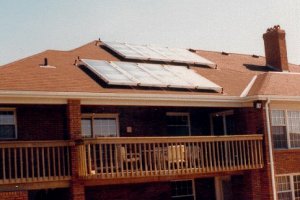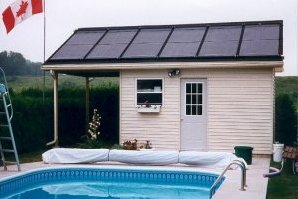|
 Heating
swimming pools is one of the most effective applications of solar energy
today. Heating
swimming pools is one of the most effective applications of solar energy
today.
|
|
| Homeowners
often spend as much heating their pools during the summer as they do heating
their homes in the winter! The cost of a solar pool heater is much less
than that of year-round systems because there is no need for panel glazing
or freeze protection during the pool season. An absolute minimal operating
cost means that the initial investment can be paid
off with the savings in as little as 3-5 years while enjoying the benefits
of an extended pool season. |
 The
operation of a solar pool heater
is simple. Pool water is sent to the collector panels
(typically mounted on your roof) usually by the existing filter pump.
Depending on your particular setup, installing a solar system may require
a larger pump. As the water circulates through the panels it absorbs
the heat of the sun and is then discharged back into the pool, raising
its temperature. There are a variety of panel sizes and configurations
that can be adapted as needed to suit the individual’s requirements.
Systems may be also automated to control and maintain a user-defined
pool temperature. Our tough, versatile panels are made right here in
Canada, and come with a 10 year manufacturer's warranty. Ask
for details. The
operation of a solar pool heater
is simple. Pool water is sent to the collector panels
(typically mounted on your roof) usually by the existing filter pump.
Depending on your particular setup, installing a solar system may require
a larger pump. As the water circulates through the panels it absorbs
the heat of the sun and is then discharged back into the pool, raising
its temperature. There are a variety of panel sizes and configurations
that can be adapted as needed to suit the individual’s requirements.
Systems may be also automated to control and maintain a user-defined
pool temperature. Our tough, versatile panels are made right here in
Canada, and come with a 10 year manufacturer's warranty. Ask
for details.
|
 Site
evaluation for the panels of a solar pool heating system
is similar to the siting of collectors for residential hot water systems,
with a few variations. Since the system is being optimised for summer
use, where the sun progresses from northeast to northwest with longer
days, the panels can be placed on east and west-facing roofs. However,
the system may have to be enlarged to compensate for the loss of sunshine
hours in the morning and the evening. Site
evaluation for the panels of a solar pool heating system
is similar to the siting of collectors for residential hot water systems,
with a few variations. Since the system is being optimised for summer
use, where the sun progresses from northeast to northwest with longer
days, the panels can be placed on east and west-facing roofs. However,
the system may have to be enlarged to compensate for the loss of sunshine
hours in the morning and the evening. |
 |
 Sizing
a solar system for a pool is straightforward, based loosely
on the surface area of the pool. Important information for sizing also
includes roof orientation, pool shading, and whether or not an insulating
blanket is being used. Assuming a south facing roof, unshaded pool, and
a blanket, use a figure of 50% of the area of the pool. Without a solar
blanket, which works to retain much of the pool’s heat (particularly
at night), increase panel area to 75% of the pool area. For pool shading,
add 5% for each hour that the pool is shaded between 10am and 4pm. Sizing
a solar system for a pool is straightforward, based loosely
on the surface area of the pool. Important information for sizing also
includes roof orientation, pool shading, and whether or not an insulating
blanket is being used. Assuming a south facing roof, unshaded pool, and
a blanket, use a figure of 50% of the area of the pool. Without a solar
blanket, which works to retain much of the pool’s heat (particularly
at night), increase panel area to 75% of the pool area. For pool shading,
add 5% for each hour that the pool is shaded between 10am and 4pm.
For shaded pools without blankets, or unfavourable roof orientation, the
panel area can approach or exceed 100% of the pool surface.
|
 System
performance is competitive with conventional heating
systems System
performance is competitive with conventional heating
systems. The solar pool panels usually heat the water
to between 3°C (5 °F)
and 5 °C
(8 °F)
warmer than the pool would otherwise be. This usually takes several days,
depending on the amount of sunlight, the air temperature, and that of
the pool water. As the pool becomes increasingly warm, so the efficiency
of the solar system decreases – experienced as lower daily temperature
gains. A properly sized solar pool heating system can raise a pool from
50 °C
to 80 °C
in 5 consecutive sunny days in May. Installing
controls on the solar pool heating system will produce additional energy
because the system activates automatically when the sun's energy is available.
If the pool gets too hot the solar system can be switched off or used
to cool the water by running it at night.
There
is no precipitation of lime or calcium
within the solar pool panels as commonly afflicts conventional gas heaters,
due to the low temperature differences between panel heated water and
the rest of the pool (3 to 5°C as opposed to 50°C for a gas heater).
Panels operate at 10 to 12 psi, though may take higher pressures up to
40 psi. |
|
 Solar
pool heating features attractive economics. A solar pool
heating system will pay for itself in short order, typically between 3
and 5 years. Solar
pool heating features attractive economics. A solar pool
heating system will pay for itself in short order, typically between 3
and 5 years.
A common 16 x 32 ft pool, opening on 24th May and closing on Labour Day
weekend, using a pool blanket and maintaining 27°C
(82°F)
with natural gas will cost between $400 and $800 per season for the fuel.
A solar pool heater has a higher outlay at first, but the cost of sunshine
is zero, and not subject to rising prices. Many homeowners who purchase
a gas heater use it for the first year and then turn the thermostat down
(shortening the pool season) after realizing the high cost of running
the system.
|

